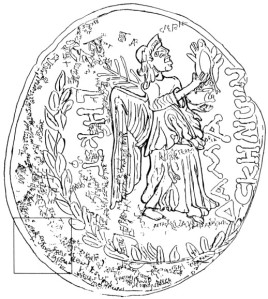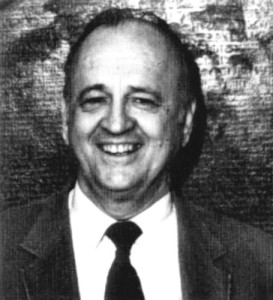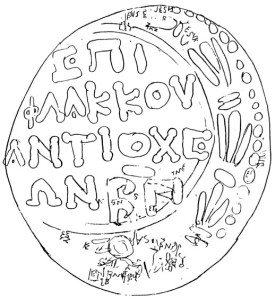Jerry Vardaman’s “microletters” on Roman coins
This is an odd one, and it’s
something that seems to have passed by the notice of most “alternative”
archaeologists. It concerns some claims made by a genuine academic
archaeologist that relate to coinage of the late first century BCE and
early first century CE, which he believed demonstrated that the
chronology of the career of Jesus of Nazareth have been dated wrongly.
These matters of chronology are not the focus of interest here (indeed,
they are abstruse and relate more to biblical exegesis and religious
history than to archaeology as such): it is the claim that coins minted
in the eastern (predominantly Greek speaking) part of the Roman Empire
contain what are claimed to be “microletters”. These are microscopic
letters that are alleged to have been created on the coin dies by the
moneyers who struck them. It is an unusual claim, but coming from an
academic archaeologist, ought to be examined carefully. After all,
academics never make mistakes, do they?
The discoverer of the “microletters” was Ephraim Jeremiah (‘Jerry’) Vardaman (1927-2000), a lecturer in archaeology and religion at Mississippi State University in Starkville (Mississippi, USA), where he was the founder and director of the Cobb Institute of Archaeology from 1973 to 1981, and from which he retired in 1992. He had previously been a Baptist Bible chair teacher at Tarleton State College (now University), an adjunct teacher of Old Testament at The Southwestern Baptist Theological Seminary from 1956 to 1958 and assistant professor and associate professor of New Testament archaeology at The Southern Baptist Theological Seminary (Louisville, Kentucky, USA) from 1958 to 1972. He also taught at the Hong Kong Baptist Seminary,
perhaps after his retirement from Mississippi State University; he was
certainly leading seminars there in 1998. His bachelor’s degree was
awarded by Southwestern Seminary and he obtained two doctorates, one
from the Southwestern Baptist Theological Seminary in 1957 (on Hermeticism and the Fourth Gospel) and the other from Baylor University in 1974 (on The Inscriptions of King Herod I). He undertook postdoctoral work at both the University of Oxford (UK) and the Hebrew University of Jerusalem
(Israel). He excavated extensively in the Middle East, at the sites of
Bethel, Shechem, Ramat Rachel, Caesarea, Ashdod, Macherus and Elusa. All
in all, this is an impressive curriculum vitae and one that means we should take Dr Vardaman’s ideas very seriously.
Jerry Vardaman’s claims
Although Jerry Vardaman never published any peer-reviewed papers on his discovery, his paper “Jesus’ Life, A New Chronology” in Chronos, Kairos, Christos I (Eisenbrauns, 1989) introduced the concept of microletters:
These discoveries resulted from research done in the coin room of the British Museum in the summer of 1984, when Nikos Kokkinos was working with me. Since Kokkinos and I have not formally discussed the following conclusions, I alone must be held accountable for them, even though we do agree on at least two basic points: the existence of microletters on ancient coins and the date of Jesus’ birth… On both subjects I present evidence found on coins of the period, coins that are literally covered with microletters.
Apart from this chapter in a relatively
obscure publication on biblical chronology, there are no formally
published reports of the discovery. A series of three lectures,
delivered to the Hong Kong Baptist Theological Seminary in 1998 has been
in circulation for some time; they can be downloaded here as poor
quality pdfs 1, 2 and 3.
That is the total of Vardaman’s output on the subject of microletters,
although it should be noted that he also claimed to identify them on
stone-cut inscriptions.
The academic response was almost
non-existent. There were no (reported) attempts by others to validate
Vardaman’s alleged discovery, no critiques of his technique and, most
worryingly, no public statement on the matter by Nikos Kokkinos,
alleged to have been the co-discoverer of microletters. Nikos Kokkinos
is well known as an expert on ancient coinage and on the coinage of the
Herodian dynasty in particular, but he seems never to have published
anything claiming to have detected microletters on the objects he
studies. He is someone who is unafraid of courting controversy (he was
one of the co-authors of Centuries of Darkness,
a radical attempt to revise the chronology of the ancient Near East and
Aegean that has not met with the approval of the majority of scholars),
so this failure to mention them is very surprising. The only response
seems to have been a review, “Theory of Secret Inscriptions on Coins is
Disputed”, by the prominent numismatist David Hendin in The Celator
(Volume 5 no 3 (March 1991), 28-32). The magazine published a rebuttal
to Hendin’s criticisms by Jerry Vardaman, which added no new evidence to
his published work.
Critique of the “microletters”

Another example of microletters, after Vardaman’s “Jesus’ Life, A New Chronology” Figure 2 (reverse)
The lack of acknowledgement by the wider
academic community is not necessarily a result of a general
unwillingness to look at Jerry Vardaman’s ideas, nor is it the closing
of ranks against novel hypotheses (a claim that many “alternative”
archaeologists make to explain why mainstream archaeologists tend to
ignore their works). It is a direct result of Vardaman’s failure to
publish his results adequately by submitting them to peer-reviewed
publications. It is also because of the audience to which he pitched his
ideas: instead of presenting them to numismatists and epigraphers, who
would be those best placed to evaluate them, he concentrated on the
religious studies audience, particularly those of a biblical literalist
bent. In some ways, this is not surprising (Vardaman was an ordained
Baptist minister), but it is worrying.
One possibility for the lack of wider
discussion of “microletters” is that other archaeologists simply did not
believe that they exist. There are enormous problems with them, of
course. Although Vardaman does not supply scales to his drawings of the
coins, the letters he claims to have detected are tiny, less than half a
millimetre in height. They could only have been added to the coin dies
using a very fine, hard-tipped scriber of some kind, although he
produced no archaeological evidence for this type of tool. We must also
ask ourselves why an ancient coin die-maker would have added words and
phrases that would have been invisible to the coin users. And why did he
use a mixture of Greek and Latin on coins that have regular
inscriptions only in Greek? How have letters so small survived the
day-to-day wear to which all coins are subject so that Vardaman could
discover them? How are they visible beneath the patina that develops on
all archaeologically recovered coins? If corrosion products have been
removed or stabilised, how have the microletters survived the cleaning
process? These are insurmountable difficulties and Vardaman was never
questioned about them.
There is a more serious problem, though.
As well as the promiscuous mixing of Greek and Latin words in the
microletter inscriptions, there is at least one instance published by
Vardaman of the letter J, used in the name Jesus. This letter simply did
not exist in either the Greek or Latin alphabets of the time of Jesus:
it was invented by the Italian humanist Gian Giorgio Trissino
(1478–1550) to represent a sound for which the existing Latin alphabet
of Early Modern period had no character. It was based on the final -i in
Roman numerals in medieval manuscript traditions, where ii, iii, vii
and viii were conventionally written ij, iij, vij, viij, a purely
decorative feature. It can not have been “microinscribed” on a coin of
the first century CE.
Explaining non-existent “microletters”
So what are we to make of Vardaman’s
hypothesis? Well, it’s bunk, pure and simple. It is Bad Archaeology of a
very obvious kind: Jerry Vardaman was seeing things that just don’t
exist. We have to ask ourselves why he did so. He does not seem to have
set out to hoax people and seems genuinely to have believed in the
existence of microletters. The well known atheist historian Richard Carrier has suggested that in later life, Vardaman was suffering from a “chronic mental illness”.
This may be going too far. Jerry Vardaman was certainly deluded about
the existence of his microletters and continued to assert that he was
correct, without bringing forward any evidence, until the end of his
life. I suspect that his religious convictions had a part to play in his
insistence on their reality.
As a Baptist of decidedly literalist
leanings, Jerry Vardaman regarded scripture as infallible; the well
known problem of the impossible date for the birth of Jesus given in the
Gospel of Luke, who appears to date it to 6 CE during the governorship
of Quirinus in Syria, has led to a variety of ingenious explanations.
Vardaman was of the view that there were two governors of Syria named
Quirinus: the one mentioned by Josephus and well known to history and an
earlier, more shadowy figure, who was governor in 12 BCE, the date
Vardaman preferred for the birth of Jesus. His microletters formed a
major element in his identification of the supposedly early Quirinius
(as did microletters on stone inscriptions), who is otherwise unknown.
Vardaman’s desperation to confirm the account of Luke in the face of the
enormous difficulty posed by the implied date of the census that would
have brought Joseph and Mary to Bethlehem led him into serious errors of
judgement: he literally saw what he wanted.



